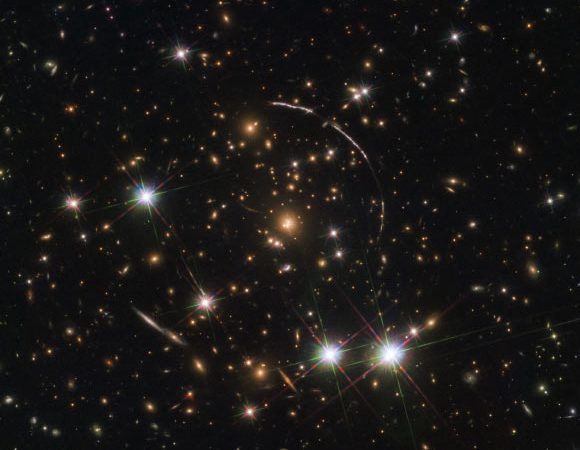An effect called strong gravitational lensing has allowed the NASA/ESA Hubble Space Telescope to see the same remote galaxy twelve times. Called PSZ1 G311.65-18.48, the galaxy is almost 11 billion light-years from Earth and has been lensed by a massive foreground galaxy cluster 4.6 billion light-years away.
Source: Sci News
Hubble uses gravitational lensing to study objects otherwise too faint and too small for even its extraordinarily sensitive instruments.
Nicknamed the Sunburst Arc, PSZ1 G311.65-18.48 is no exception, despite being one of the brightest gravitationally lensed galaxies known.
The lens makes various images of this galaxy between 10 and 30 times brighter. This allows Hubble to view structures as small as 520 light-years across — a rare detailed observation for an object that distant.
This compares reasonably well with star forming regions in galaxies in the local Universe, allowing astronomers to study the galaxy and its environment in great detail.
Hubble’s observations showed that the PSZ1 G311.65-18.48 is an analogue of galaxies which existed at a much earlier time in the history of the Universe: a period known as the Epoch of Reionization, an era which began only 150 million years after the Big Bang.
It was a key era in the early Universe, one which ended the ‘dark ages,’ the epoch before the first stars were created when the Universe was dark and filled with neutral hydrogen.
Once the first stars formed, they started to radiate light, producing the high-energy photons required to ionize the neutral hydrogen.
This converted the intergalactic matter into the mostly ionized form in which it exists today.
However, to ionize intergalactic hydrogen, high-energy radiation from these early stars would have had to escape their host galaxies without first being absorbed by interstellar matter.
So far only a small number of galaxies have been found to ‘leak’ high-energy photons into deep space. How this light escaped from the early galaxies remains a mystery.
The analysis of PSZ1 G311.65-18.48 helps astronomers to add another piece to the puzzle — it seems that at least some photons can leave the galaxy through narrow channels in a gas rich neutral medium. This is the first observation of a long-theorized process.
While this process is unlikely to be the main mechanism that led the Universe to become reionized, it may very well have provided a decisive push.
Source: Sci News

































Leave a Comment
You must be logged in to post a comment.